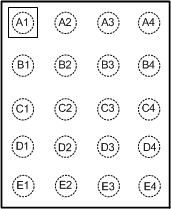ZHCSE58C April 2012 – September 2015 LM3533
PRODUCTION DATA.
- 1 特性
- 2 应用范围
- 3 说明
- 4 修订历史记录
- 5 Pin Configuration and Functions
- 6 Specifications
-
7 Detailed Description
- 7.1 Overview
- 7.2 Functional Block Diagram
- 7.3 Feature Description
- 7.4
Device Functional Modes
- 7.4.1 High-Voltage Boost Converter
- 7.4.2 Integrated Charge Pump
- 7.4.3 LED Current Mapping Modes
- 7.4.4 LED Current Ramping
- 7.4.5 Brightness Register Current Control
- 7.4.6 PWM Control
- 7.4.7 ALS Current Control
- 7.4.8
ALS Functional Blocks
- 7.4.8.1 ALS Input
- 7.4.8.2 Analog Output Ambient Light Sensors (ALS Gain Setting Resistors)
- 7.4.8.3 PWM Output Ambient Light Sensors (Internal Filtering)
- 7.4.8.4 Internal 8-Bit ADC
- 7.4.8.5 ALS Averager
- 7.4.8.6 Initializing the ALS
- 7.4.8.7 ALS Algorithms
- 7.4.8.8 ALS Rules
- 7.4.8.9 Direct ALS Control
- 7.4.8.10 Up-Only Control
- 7.4.8.11 Down-Delay Control
- 7.4.9 Pattern Generator
- 7.4.10 Fault Flags/Protection Features
- 7.5 Programming
- 7.6 Register Maps
- 8 Application and Implementation
- 9 Power Supply Recommendations
- 10Layout
- 11器件和文档支持
- 12机械、封装和可订购信息
5 Pin Configuration and Functions
YFQ Package
20-Pin DSBGA
Top View

Pin Functions
| PIN | TYPE | DESCRIPTION | |
|---|---|---|---|
| NO. | NAME | ||
| A1 | C− | OUT | Integrated charge pump flying capacitor negative terminal. Connect a 1-µF ceramic capacitor from C+ to C−. |
| A2 | C+ | OUT | Integrated charge pump flying capacitor positive terminal. Connect a 1-µF ceramic capacitor from C+ to C−. |
| A3 | CPOUT | OUT | Integrated charge pump output terminal. Bypass CPOUT to GND with a 1-µF ceramic capacitor. |
| A4 | IN | IN | Input voltage connection. Bypass IN to GND with a minimum 2.2-µF ceramic capacitor. |
| B1 | SCL | IN | Serial clock connection for I2C-compatible interface. |
| B2 | SDA | I/O | Serial data connection for I2C-compatible interface. |
| B3 | OVP | IN | Overvoltage sense Input. Connect OVP to the positive terminal of the inductive boost's output capacitor (COUT). |
| B4 | GND | GND | Ground |
| C1 | HVLED1 | IN | Input pin to high-voltage current sink 1 (40 V maximum). The boost converter regulates the minimum of HVLED1 and HVLED2 to 0.4 V. |
| C2 | INT | OUT | ALS interrupt output (INT). When INT mode is enabled this pin becomes an open-drain output that pulls low when the ALS changes zones. On power-up, INT mode is disabled and is high impedance and must be tied high or low. |
| C3 | PWM | IN | PWM brightness control input for CABC operation. PWM is a high-impedance input and cannot be left floating. |
| C4 | SW | IN | Drain connection for the internal NFET. Connect SW to the junction of the inductor and the Schottky diode anode. |
| D1 | HVLED2 | IN | Input pin high-voltage current sink 2 (40 V maximum). The boost converter regulates the minimum of HVLED1 and HVLED2 to 0.4 V. |
| D2 | ALS | IN | Ambient light sensor input. |
| D3 | HWEN | IN | Hardware enable input. Drive this pin high to enable the device. Drive this pin low to force the device into a low power shutdown. HWEN is a high-impedance input and cannot be left floating. |
| D4 | LVLED5 | IN | Low-voltage current sink 5 |
| E1 | LVLED1 | IN | Low-voltage current sink 1 |
| E2 | LVLED2 | IN | Low-voltage current sink 2 |
| E3 | LVLED3 | IN | Low-voltage current sink 3 |
| E4 | LVLED4 | IN | Low-voltage current sink 4 |